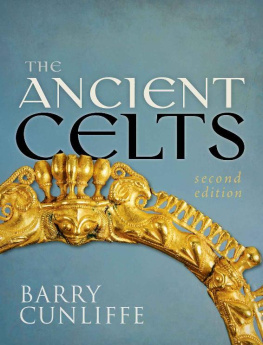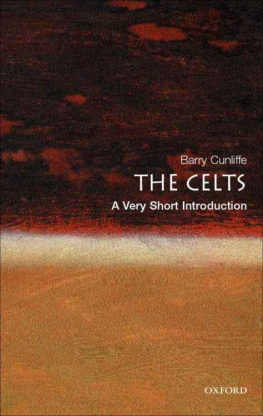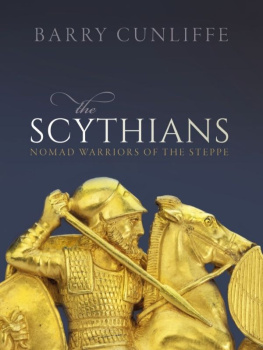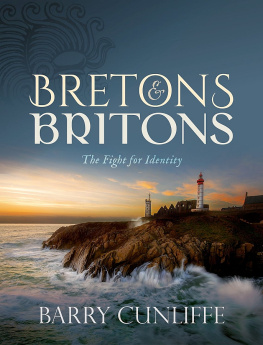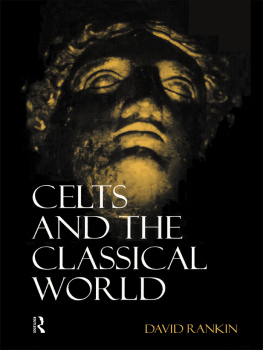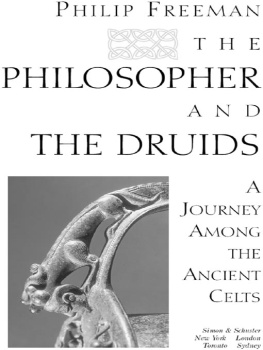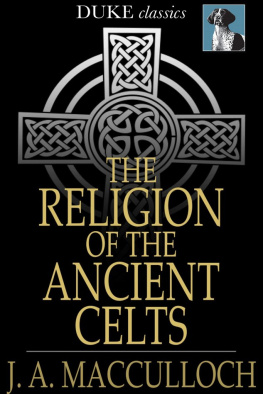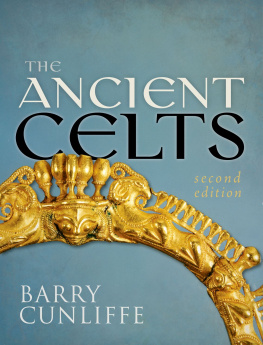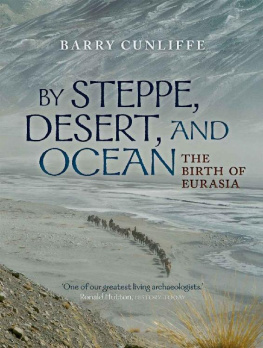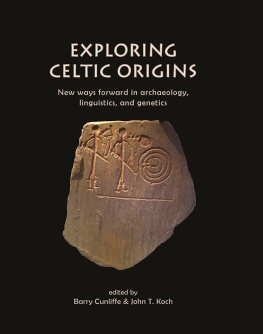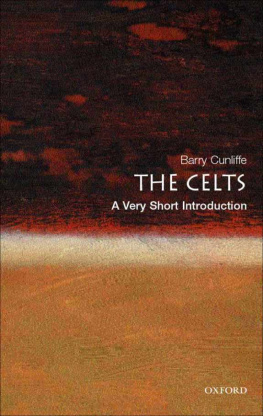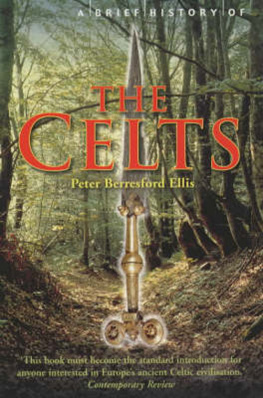THE ANCIENT CELTS

Great Clarendon Street, Oxford, OX2 6DP
United Kingdom
Oxford University Press is a department of the University of Oxford. It furthers the Universitys objective of excellence in research, scholarship, and education by publishing worldwide. Oxford is a registered trade mark of Oxford University Press in the UK and in certain other countries
Barry Cunliffe 2018
The moral rights of the author have been asserted
First Edition published by Oxford University Press in 1997
Published in Penguin Books 1999
Second Edition published in 2018
Impression: 1
All rights reserved. No part of this publication may be reproduced, stored in a retrieval system, or transmitted, in any form or by any means, without the prior permission in writing of Oxford University Press, or as expressly permitted by law, by licence or under terms agreed with the appropriate reprographics rights organization. Enquiries concerning reproduction outside the scope of the above should be sent to the Rights Department, Oxford University Press, at the address above
You must not circulate this book in any other form and you must impose the same condition on any acquirer
Published in the United States of America by Oxford University Press 198 Madison Avenue, New York, NY 10016, United States of America
British Library Cataloguing in Publication Data
Data available
Library of Congress Control Number: 2017953031
ISBN9780198752929
ISBN9780198752936 (pbk.)
ebook ISBN 9780191067228
Typeset by Sparkswww.sparkspublishing.com
Printed in Great Britain by Bell & Bain Ltd., Glasgow
Links to third party websites are provided by Oxford in good faith and for information only. Oxford disclaims any responsibility for the materials contained in any third party website referenced in this work.
preface to the second edition
The First Edition of this book was written twenty years ago when the subject, indeed the validity, of the Celts was being actively debated. Most archaeologists were agreed that our perceptions of the ancient Celts, which had changed little over the last century, were in urgent need of revision. A certain nostalgic cosiness had crept in and although new data was accumulating fast there had been little critical debate. Old mantras about Celticness were repeated bringing comfort rather than stimulation. In the debate that followed in the 1990s and the early years of this millennium the way in which the concept of the Celt had been constructed was energetically reassessed, old preconceptions were cast off, and new ways were developed to try to improve our understanding of the European barbarians who were referred to as Celts or Gauls by their Mediterranean neighbours.
What became clear, early in the debate, was that the models we had been using were no longer fit for purpose. They were predicated on a theory, first coherently formulated in the early eighteenth century, to explain variations in a language group to which the name Celtic had been given. It was not until the early nineteenth century that the nascent discipline of archaeology began slowly to yield relevant data. Since philology was the senior discipline, the findings of the archaeologists were, inevitably, interpreted in terms of the linguistic model. So it was until the last decades of the twentieth century, when it began to become apparent that the archaeological evidence could no longer be forced to fit the old linguistic theories. It was in this atmosphere of new-found confidence that some archaeologists began to consider fresh models suggesting that the Celtic language may have originated in the Atlantic zone of Europe and may have spread eastwards, perhaps as early as the third millennium bc .
The discussion has continued over the last fifteen years or so, some groups trying to find a rapprochement between archaeologists and linguists. Now, with the development of new techniques to extract ancient DNA from human bones, an entirely new source of data is becoming available, totally independently of archaeology and linguistics. Once sufficient ancient DNA evidence becomes available and is brought into meaningful juxtaposition with the archaeological data, reliable narratives of human mobility, exploring both connectivity and remoteness, will be able to be constructed for Europe. These will challenge linguists to look anew at their long-held theories. Out of all this the history of the people who spoke the Celtic language will emerge. These are exciting times. The exploration of the Celts, then, is a worthwhile pursuit since it draws us deep into the processes which help us to begin to understand the complexity of our past.
Barry Cunliffe
Oxford
December 2017
preface to the first edition
For two and a half thousand years the Celts have continued to fascinate those who have come into contact with them. For the Greeks and Romans the fascination was tinged with fear tempered with a degree of respect for Celtic prowess in battle. Later generations, further removed from the reality of the barbarian Celts of the first millennium bc , generated their own myths and stereotypes about the past, re-creating Celtic ancestors for themselves in the image of the day designed to explain their own attitudes and aspirations and to provide a legitimacy for actions. The study of the Celts and of our changing visions of them offer an incomparable insight into the human need to establish an identityand of the difficulties which this poses to archaeologists, who, by their best endeavours, attempt to remain objective.
It could be argued that biased historical anecdotes, ill-understood patterns of early language development, and hard archaeological factsthe artefacts, ecofacts, and structures of the past recovered through excavationshould not, and indeed cannot, be brought together to create a coherent picture of the past. The position is firmly taken by some and energetically argued; it is not one with which I have much sympathy. Given an array of disparate evidence, we would, I believe, be failing if we were to fight shy of the challenges posed by using every available scrap in our attempt to construct a European protohistory. In doing so we will, inevitably, be drawn into simplification and generalization, laying ourselves open to criticism from the purists, but better the attempt to create a whole, however imperfect, than to be satisfied with the minute examination of only a part.
In writing this book, within the entirely reasonable constraints suggested by the publishers, I have found it impossible to go into areas of detail which I would like to have covered, while at the same time being drawn into the wider themes of European pre- and protohistory. Rather than adhere to the preconceptions of my original plan, I have allowed myself to be led by the subject. What emerges is much less an archaeology than it might have been.
My other indulgence is to have written the text during a sabbatical term living in a house on the north coast of Brittany, overlooking a narrow bay to the headland of Le Yaudet beyond. In the Late Iron Age, the promontory was defended by a massive rampart, and it is quite conceivable, though yet unproven, that it was one of the communities attacked by Caesar in 56 bc . Living here in Brittany has provided a constant reminder of the Celtic world. In the nearby church at Loguivy-ls-Lannion we attended a musical celebration for the pardon of St Ivy. The long address of welcome was in Breton. Then followed music and singing dominated by bagpipes and bombardes identical to those played by the shepherds in the Adoration depicted on the seventeenth-century altarpiece above. Two months later, in July, the local fte folklorique was held within the promontory fort of Le Yaudet. The event is an entirely new creation only some ten years old, but it is fast becoming a focus for the community. The displays of old farm machinery and ancient crafts are as fascinating to the local population as they are to the tourists, and in the evening, as dinner in the open air proceeds, old and young alike join in the singing of Breton songs and the dancing, and listen to the telling of stories. It is, of course, a conscious re-creation of a past, but a past not long gone and one which offers a much-needed sense of identity and continuity in a fast-changing world.

